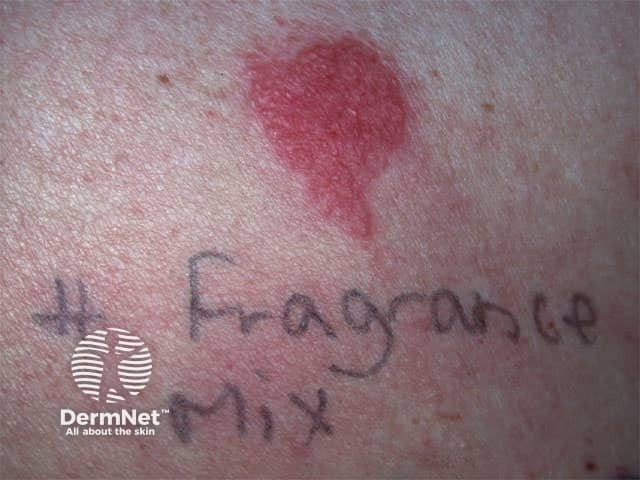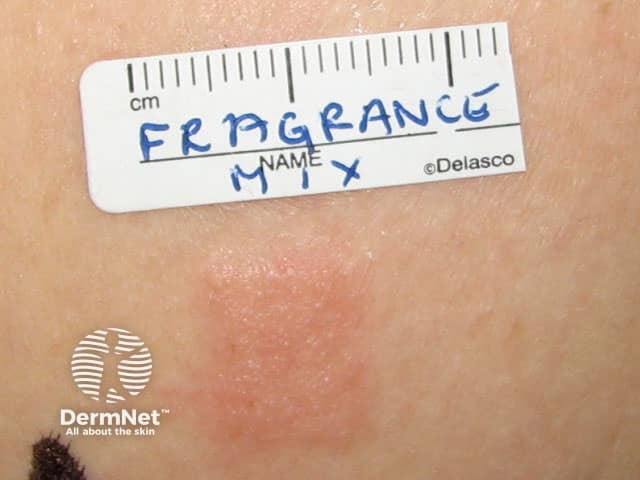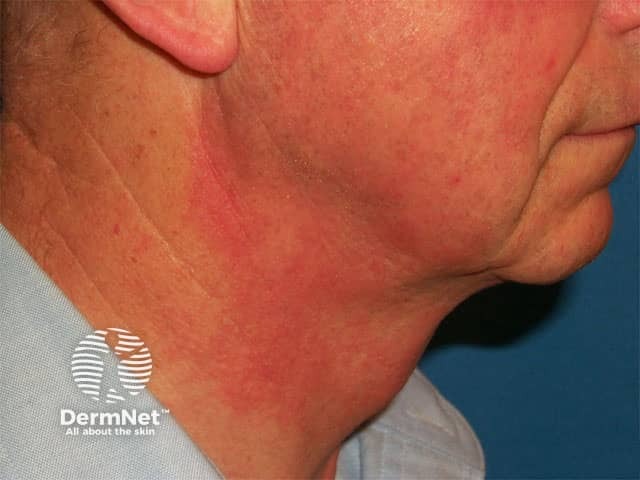Main menu
Common skin conditions

NEWS
Join DermNet PRO
Read more
Quick links
Fragrance mix allergy — extra information
Introduction What is it and where is it found? Reactions Diagnosis Prevention Further information
Introduction
Fragrance was declared the Contact Allergen of the Year for 2007 by the American Contact Dermatitis Society (ACDS). See Fragrance allergy.
There are more than 5000 different fragrances that are in use today. In any one product, the number of fragrances used can be many. Fortunately, only a small number of fragrances are actually common sensitisers and cause allergy in sensitive individuals.
What is fragrance mix and where is it found?
Fragrance mix is a mixture of 8 individual fragrances that are used in patch tests to screen for fragrance allergy. The 8 listed are the most common allergy-causing fragrances that are used across many products for their fragrant and flavouring properties.
Components of Fragrance Mix
Fragrance |
Used/found in |
|---|---|
Cinnamic alcohol
|
|
Cinnamic aldehyde
|
|
Eugenol
|
|
Isoeugenol
|
|
Geraniol
|
|
Alpha amyl cinnamic alcohol
|
|
Hydroxycitronellal
|
|
Oakmoss absolute
|
|
Fragrances may also be found in the workplace. Paints, cutting fluids and metalworking fluids may contain fragrances to mask offending odours. Fragrances may also be circulated through air conditioning.
What are the reactions to fragrance mix allergy?
Typical allergic contact dermatitis reactions may occur in individuals allergic to fragrance mix or any other chemically related substances. The dermatitis is characteristically located on the eyelids, face, hands and arms. There may be intense swelling and redness of the affected area within a few hours or the rash may appear after a day or two of the product being used. Sometimes symptoms may only be redness, dryness and itching.
Oral exposure may cause sore mouth (tongue) and a rash of the lips or angles of the mouth. Flare-ups of dermatitis in fragrance-sensitive individuals may occur if they use or consume products containing fragrance allergens.

Patch tests

Patch tests

Contact allergy to fragrance in aftershave
Am I allergic to fragrances?
Sensitivity to a perfume, cream or lotion is usually the first indicator of an allergy to fragrance. Patch testing using fragrance mix and Balsam of Peru detects approximately 75% of fragrance allergy cases. A positive patch to fragrance mix indicates that you are allergic to one or more fragrance chemicals. An estimated 1–2% of the general population is allergic to fragrance.
Self-testing a product for fragrance allergy is possible but should be done only after first talking with your doctor. Open application tests should be done only with products that are designed to stay on the skin such as cosmetics and lotions. Apply a small amount (50 cents sized area) of the product to a small tender area of skin such as the bend of your arm or neck for several days in a row. Examine the area each day and if no reaction occurs, it is unlikely you are allergic to it. However, it may still not be suitable for you as it can still cause an irritant reaction. Products such as shampoos, conditioners, soaps and cleansers should not be tested in this way as they frequently cause an irritant contact dermatitis if they are covered or overused on tender areas.
What should I do to avoid fragrance allergy?
If you have a fragrance allergy the best way to avoid any problems is by avoiding all products that contain fragrances of any sort. Unfortunately, fragrance allergy is usually life-long and gets worse with continued exposure.
There are more than 5000 different fragrances that are in use today. In any one product, the number of fragrances used can be many. Fortunately, only a small number of fragrances are actually common sensitisers and cause allergy in sensitive individuals.
Often products are only labelled as containing fragrance and do not identify the individual chemicals used to make up the fragrance. You should avoid all products that are labelled with any of the following names. These include other names for fragrances, individual fragrance allergens and other related substances.
Other names for fragrances |
Individual fragrance allergens |
Other potential allergens |
|---|---|---|
|
|
|
Be wary of products that are labelled fragrance-free or unscented, as these terms may not necessarily mean they do not contain fragrance chemicals; they just imply the product has no perceptible odour. These products may possibly contain a masking fragrance that is used to cover up the odour of other ingredients.
Note that clothes washed in scented laundry detergent can be a problem with prolonged skin contact of the garment in the presence of moisture and heat. It would be best to use fragrance-free laundry detergent.
Alert your doctor or dentist to the fact that you have an allergy to fragrance mix. If you are highly sensitive, your doctor may also recommend a special diet that eliminates foods to which these allergens or related allergens are added as a flavouring.
Your dermatologist may have further specific advice, particularly if you are highly sensitive to fragrance mix.
Further information
Compound |
Formula |
CAS number: |
Cinnamic alcohol |
C9H10O |
104-54-1 |
Cinnamic aldehyde |
C9H8O |
104-55-2 |
Alpha amyl cinnamic aldehyde |
C14H18O |
122-40-7 |
Eugenol |
C10H12O2 |
97-53-0 |
Isoeugenol |
C10H22N2 |
97-54-1 |
Hydroxycitronellal |
C10H18O2 |
107-75-5 |
Geraniol |
C10H18O |
106-24-1 |
Oakmoss absolute |
Cross-reactions
- Balsam of Peru
- Cassia oil
- Cinnamon
- Cloves
- Citronella candles
- Ethylene brassylate
- Tiger balm
- Sensitisers
- Cinnamic alcohol, cinnamic aldehyde, alpha amyl cinnamic aldehyde, eugenol, isoeugenol, hydroxycitronellal, geraniol, oakmoss absolute
Patch test
- Fragrance mix 8%
Reference
On DermNet
- Fragrances and perfumes
- Fragrance allergy
- Allergic contact dermatitis to essential oils
- Cosmetics allergy
- Dermatitis
- Allergic contact dermatitis
- Patch testing
- Topical medication allergy
- Open application test
- Occupational skin disorders in homemakers
Other websites
- T.R.U.E. Tests: this site provides a wide range of information on contact dermatitis and contact allergy testing
- Allergy New Zealand
- Fragranced Products Information Network: Impact of fragrance on the skin
- Allergic contact dermatitis – Medscape Reference
